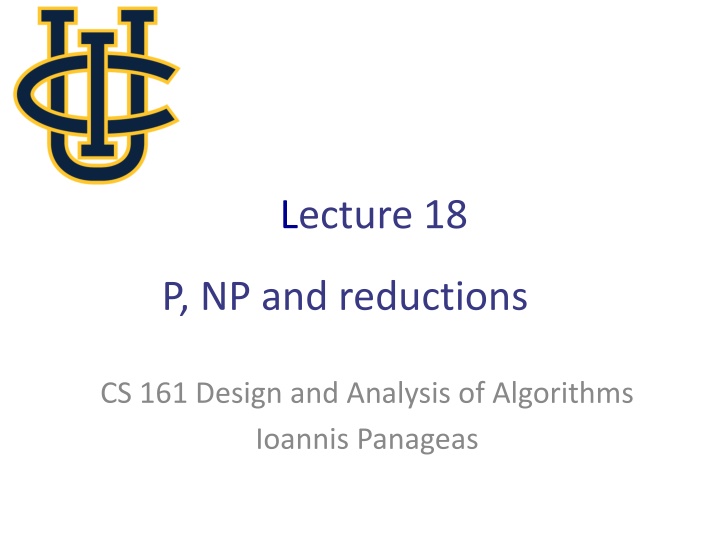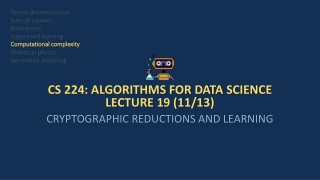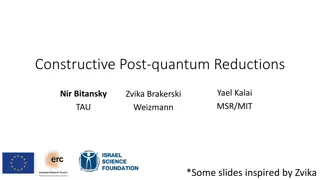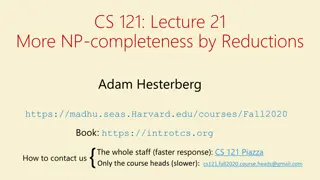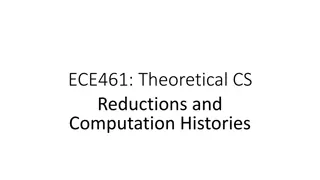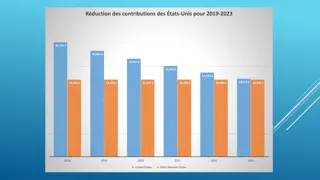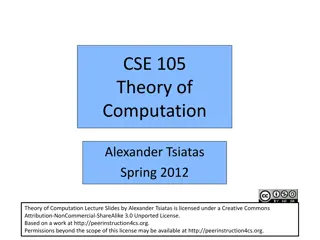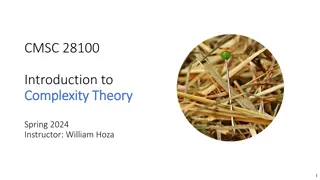Lecture 18 P, NP and reductions
This lecture covers topics on P, NP, and reductions in the context of algorithm design and analysis. Presented by Ioannis Panageas, it delves into the complexities and nuances of computational problems, offering valuable insights and methodologies for understanding and solving them efficiently. By exploring the interplay between complexity classes and reduction techniques, students gain a deeper understanding of algorithmic strategies and approaches. With a focus on critical thinking and problem-solving skills, this lecture equips learners with the tools needed to tackle challenging algorithmic problems in a systematic and effective manner.
Download Presentation

Please find below an Image/Link to download the presentation.
The content on the website is provided AS IS for your information and personal use only. It may not be sold, licensed, or shared on other websites without obtaining consent from the author.If you encounter any issues during the download, it is possible that the publisher has removed the file from their server.
You are allowed to download the files provided on this website for personal or commercial use, subject to the condition that they are used lawfully. All files are the property of their respective owners.
The content on the website is provided AS IS for your information and personal use only. It may not be sold, licensed, or shared on other websites without obtaining consent from the author.
E N D
Presentation Transcript
Lecture 18 P, NP and reductions CS 161 Design and Analysis of Algorithms Ioannis Panageas
Different time complexities Different algorithms can have different time complexities. Notation (input size = ?) Some common complexity classes ?(1) Constant ?(log?) Logarithmic ?(?) Linear Polynomial time ?(?log?) ?(?2) ?(?3) ?(??) Log-linear Quadratic Cubic Exponential ?(?!) ?(???) Factorial Doubly-exponential We say an algorithm runs in polynomial time if its time complexity is ?(??) for some constant ?. Design and Analysis of Algorithms
P and NP Given a decision problem ? (output yes/no), there could be many possible solutions, with possibly different time complexities. The class P: We say can be solved in polynomial time or belongs in ? if there exist at least one algorithm that solves the problem and runs in polynomial time. Design and Analysis of Algorithms
P and NP Given a decision problem ? (output yes/no), there could be many possible solutions, with possibly different time complexities. The class P: We say can be solved in polynomial time or belongs in ? if there exist at least one algorithm that solves the problem and runs in polynomial time. The class NP: It stands for Non-deterministic polynomial time. In high level, if the answer is yes , it can be verified in polynomial time. Example: Given a number ?, is it composite? Example: Given a graph ?(?,?), does it contain a cycle? . Design and Analysis of Algorithms
Optimization Problems Problem:The traveling salesman problem Given a list of cities and the distances between each pair of cities, what is a shortest possible route that visits each city exactly once and returns to the origin city? If there are n cities, then the best known solution uses dynamic programming and has time complexity ?(?22?). best solution brute-force search + dynamic programming This problem is suspected to be not solvable in polynomial time. We still do not know Other example: 0/1 Knapsack problem. Design and Analysis of Algorithms
Convert optimization to decision problems Problem:The traveling salesman problem Given a list of cities and the distances between each pair of cities, is there a route of length at most ? that visits each city exactly once and returns to the origin city? If there are n cities, then the best known solution uses dynamic programming and has time complexity ?(?22?). best solution brute-force search + dynamic programming This problem belongs to NP. Why? Design and Analysis of Algorithms
Unsolvable problems? Question: Are there unsolvable computational problems? There are examples of unsolvable problems. The most famous one is called the halting problem. The Halting Problem: Given a computer program ? and some input ?, determine whether ? will terminate when executed with input ?. This is a decision (yes/no) problem. The answer to the halting problem is either yes or no. Yes, if ? terminates. No, if ? runs forever (e.g. enters an infinite loop). If ? is not a valid input for ?, then ? executed with input ? will terminate with an error message. Design and Analysis of Algorithms
How do we show a problem is not in P? Question: How can we prove that a problem is not in P? Short answer:For many problems, we don t know how! Current Status: We do not know of any general method that works on all problems, that can prove that a problem is not in ?. In fact, we do not even know of any general method that can prove that a problem is not solvable in linear time. We can characterize their computational difficulty using reductions. Design and Analysis of Algorithms
The idea of reductions There are so many different computational problems that we may want to solve. Do we have to solve every one of these problems from scratch? Key Idea of reductions Given a Problem ? that we want to solve, and suppose there is another Problem ? that we already know how to solve. If we can reformulate Problem ?to look like Problem ?, so that by solving Problem ?, we are able to solve Problem ?. Design and Analysis of Algorithms
The idea of reductions There are so many different computational problems that we may want to solve. Do we have to solve every one of these problems from scratch? Key Idea of reductions Given a Problem ? that we want to solve, and suppose there is another Problem ? that we already know how to solve. If we can reformulate Problem ?to look like Problem ?, so that by solving Problem ?, we are able to solve Problem ?. Example: ? = maximum matching and ? = Maxflow. Then we say that we have reduced Problem ? to Problem ?. Problem ? is at least as hard as Problem ?. Design and Analysis of Algorithms
NP-complete problems NP-complete: A problem ? is NP-complete if 1. Belongs in NP 2. Any other problem in NP reduces in poly-time to ?. In other words, ? is NP-hard. What does this mean? ? is the hardest problem in class NP. Design and Analysis of Algorithms
NP-complete problems NP-complete: A problem ? is NP-complete if 1. Belongs in NP 2. Any other problem in NP reduces in poly-time to ?. In other words, ? is NP-hard. What does this mean? ? is the hardest problem in class NP. In 1971, the first NP-complete problem appears. Theorem: The 3-SAT problem is NP-complete. (Cook Levin s Thm, 1971) Design and Analysis of Algorithms
3-SAT is NP-complete Problem: 3-SAT Given a Boolean expression ?, such that ? is a conjunction of clauses, where each clause is a disjunction of exactly 3 literals, is ? satisfiable? Design and Analysis of Algorithms
3-SAT is NP-complete Problem: 3-SAT Given a Boolean expression ?, such that ? is a conjunction of clauses, where each clause is a disjunction of exactly 3 literals, is ? satisfiable? A literal is a Boolean expression consisting of just a single Boolean variable, or the negation of a Boolean variable. Example: ?1 and ?2 are literals. A clauseis a Boolean expression of the form 1 2 ? , i.e. a disjunction of some literals 1, 2, , ?. In 3-SAT ? = 3. Example: C1 ?1 ?2 ?3 is a clause. Design and Analysis of Algorithms
3-SAT is NP-complete Problem: 3-SAT Given a Boolean expression ?, such that ? is a conjunction of clauses, where each clause is a disjunction of exactly 3 literals, is ? satisfiable? A literal is a Boolean expression consisting of just a single Boolean variable, or the negation of a Boolean variable. Example: ?1 and ?2 are literals. A clauseis a Boolean expression of the form 1 2 ? , i.e. a disjunction of some literals 1, 2, , ?. In 3-SAT ? = 3. Example: C1 ?1 ?2 ?3 is a clause. A Boolean expression is a conjunction of clauses. Example: (?? ?? ??) ( ?? ?? ??) ( ?? ?? ??) (?? ?? ??) Design and Analysis of Algorithms
Reductions in NP Example: INDEPENDENT SET (IS) Problem Given a simple undirected graph ?(?,?) and ?, is there an independent set in ? of size ?? Independent set is called a set ? ? of vertices such that pairwise the vertices in ? do not share an edge. ?1 ?3 ?2 ?4 ?7 ?6 ?5 ?8 Design and Analysis of Algorithms
Reductions in NP Example: INDEPENDENT SET (IS) Problem Given a simple undirected graph ?(?,?) and ?, is there an independent set in ? of size ?? Independent set is called a set ? ? of vertices such that pairwise the vertices in ? do not share an edge. ?1 ?3 ?2 ?4 ?7 ?6 ?5 ?8 Claim: INDEPENDENT SET is NP-complete. Proof: (1) INDEPENDENT SET belongs to NP (why?). (2) Reduce 3-SAT to INDEPENDENT SET. Since 3-SAT is NP- hard, INDEPENDENT SET is NP-hard. Design and Analysis of Algorithms
Reductions in NP Example: INDEPENDENT SET (IS) Problem Given a simple undirected graph ?(?,?) and ?, is there an independent set in ? of size ?? Independent set is called a set ? ? of vertices such that pairwise the vertices in ? do not share an edge. ?1 ?3 ?2 ?4 ?7 ?6 ?5 ?8 Claim: INDEPENDENT SET is NP-complete. Proof: (1) INDEPENDENT SET belongs to NP (why?). (2) Reduce 3-SAT to INDEPENDENT SET. Since 3-SAT is NP- hard, INDEPENDENT SET is NP-hard. Design and Analysis of Algorithms
3-SAT reduction to IS 3-SAT instance: Can you assign True, False to the variables of the formula below so that the expression is True? ? = (?1 ?2 ?3) ( ?1 ?2 ?3) ( ?1 ?2 ?3) (?1 ?2 ?3) Let s reduce the above to an IS instance. We need a graph! Design and Analysis of Algorithms
3-SAT reduction to IS 3-SAT instance: Can you assign True, False to the variables of the formula below so that the expression is True? ? = (?1 ?2 ?3) ( ?1 ?2 ?3) ( ?1 ?2 ?3) (?1 ?2 ?3) 2x 3x 1x 1x 1x 2x 2x 3x 3x 2x 3x 1x Design and Analysis of Algorithms
3-SAT reduction to IS 3-SAT instance: Can you assign True, False to the variables of the formula below so that the expression is True? ? = (?1 ?2 ?3) ( ?1 ?2 ?3) ( ?1 ?2 ?3) (?1 ?2 ?3) 2x 3x 1x 1x 1x 2x 2x 3x 3x 2x 3x 1x Design and Analysis of Algorithms
3-SAT reduction to IS 3-SAT instance: Can you assign True, False to the variables of the formula below so that the expression is True? ? = (?1 ?2 ?3) ( ?1 ?2 ?3) ( ?1 ?2 ?3) (?1 ?2 ?3) 2x 3x 1x 1x 1x 2x 2x 3x 3x 2x 3x 1x IS of size 4 Design and Analysis of Algorithms
3-SAT reduction to IS Claim: Expression ? with ? clauses is satisfiable if and only if the induced graph G has an IS of size ?. Therefore, given a graph ? and a ?, if we can identify in poly-time if there exists an Independent Set of size at least k, then we can solve in poly-time 3-SAT. Design and Analysis of Algorithms
3-SAT reduction to IS Claim: Expression ? with ? clauses is satisfiable if and only if the induced graph G has an IS of size ?. Therefore, given a graph ? and a ?, if we can identify in poly-time if there exists an Independent Set of size at least k, then we can solve in poly-time 3-SAT. Design and Analysis of Algorithms
Vertex Cover (VC) Problem: Vertex Cover (VC): Given a simple undirected graph ?(?,?) and ?, is there an vertex cover in ? of size ?? Vertex cover is called a set ? ? of vertices such that all edges are covered ? e.g., in this graph, 4 of the 8 vertices are enough to cover all edges. Design and Analysis of Algorithms
Vertex Cover (VC) Problem: Vertex Cover (VC): Given a simple undirected graph ?(?,?) and ?, is there an vertex cover in ? of size ?? Vertex cover is called a set ? ? of vertices such that all edges are covered ? e.g., in this graph, 4 of the 8 vertices are enough to cover all edges. Question: VC is NP-Complete? Answer: YES First, it belongs in NP (why?) Reduce 3-SAT to VC (or there is something simpler?) Design and Analysis of Algorithms
Reduction of IS to Vertex Cover (VC) Given a graph ?(?,?), with V = n, we want to know if there exists an Independent Set of size ?. Design and Analysis of Algorithms
Reduction of IS to Vertex Cover (VC) Given a graph ?(?,?), with V = n, we want to know if there exists an Independent Set of size ?. Lemma: Given ?(?,?), the set of vertices ? is an independent set if and only if ? ? (set of remaining vertices) is a vertex cover. Design and Analysis of Algorithms
Reduction of IS to Vertex Cover (VC) Given a graph ?(?,?), with V = n, we want to know if there exists an Independent Set of size ?. Lemma: Given ?(?,?), the set of vertices ? is an independent set if and only if ? ? is a vertex cover. Reduction: Does ? have a VC of size ? ?? Yes: Then it has an IS of size k. No: Then it does not. Design and Analysis of Algorithms
Reduction of IS to Vertex Cover (VC) Given a graph ?(?,?), with V = n, suppose there exists an Independent Set of size ?. Lemma: Given ?(?,?), the set of vertices ? is an independent set if and only if ? ? is a vertex cover. Proof: Let ? be an independent set, and ? = (?,?) be some edge. Only one of ?,? can be in ?. Hence, at least one of ?,? is in ? ?. So, ? ? is a vertex cover. The other direction is similar. Design and Analysis of Algorithms
